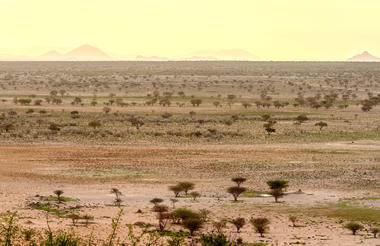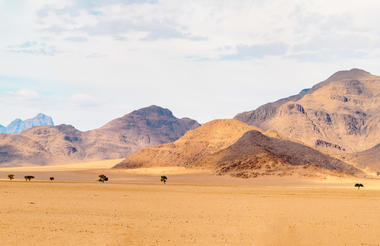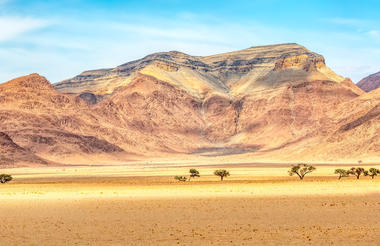Windhoek is Namibia’s capital, home to an international airport and a plethora of restaurants, shops, entertainment venues and accommodation options. The city is clean, safe and well-organised, with a colonial legacy that is reflected in its many German eateries and shops, and the widespread use of the German language. Windhoek has an interesting mix of historical architecture and modern buildings, many of which are worth a look, including the Alte Feste (Old Fort), the 1896 Christuskirche (Christ Church), and the more contemporary Supreme Court.

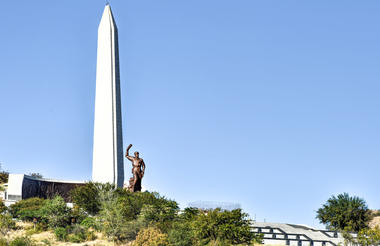
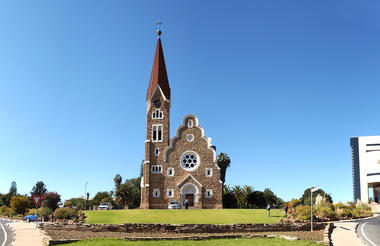
The Chobe River forms the northern boundary of the Chobe National Park, renowned for its reliable and diverse game viewing. Safaris are conducted both by boat and on land. This section of the park is best known for its elephant and hippo populations but the waters attract all manner of game including large herds of buffalo and the lions that prey on them.
As previously described
Encompassing the bustling capital city of Windhoek, and the laid-back seaside towns of Swakopmund and Walvis Bay, Central Namibia features an array of towns, deserts, and wildlife reserves. The landscape of this region is characterised by grasslands decorated with clusters of Acacia trees, between the Namib Desert to the west and the lush Kalahari to the east. Visitors can soak in the steaming waters of the Cross Barmen Hot Springs, view a wide variety of wildlife, and explore the untouched beauty of the beautiful Erongo Mountains with the breathtakingly beautiful Spitzkoppe, which offers some of the best stargazing opportunities in the country. Divers and snorkellers will enjoy the incredible marine life just off the coast of Walvis Bay. Art lovers should make sure to visit the little town of Okahandja, famous for its fine wood carving and vibrant markets.
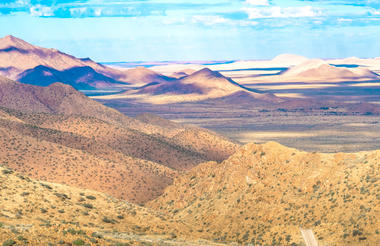
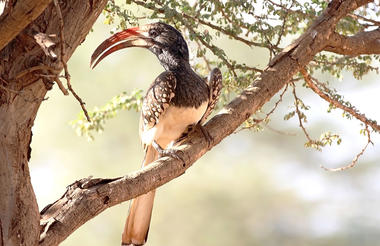
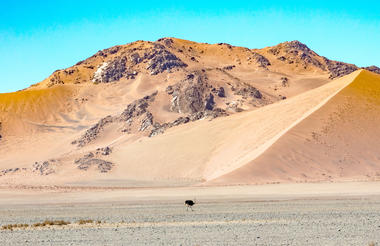
With its well-developed infrastructure, some of the best tourist facilities in Africa and an impressive list of breathtaking natural wonders, touring Namibia is truly a pleasure. Visit the capital of Windhoek and the lovely coastal town of Swakopmund to discover remnants of the country’s German influence, reflected in the architecture, culture, cuisine and the annual Oktoberfest celebrations. To properly appreciate this extraordinary country, you will have to venture out of the cities to explore the remarkable natural landscapes Namibia has to offer. These include: the impressive Fish River Canyon Park; the vast Etosha National Park teeming with local subspecies, such as desert lions, desert elephants and the Hartmann's Mountain Zebra; the hauntingly beautiful Kalahari Desert; and of course the Namib Desert stretching for nearly 1000 km along the magnificent Atlantic coastline. Namibia is an ideal destination for travellers seeking an unforgettable African experience in a uniquely beautiful untamed wilderness.
Money
Currency Namibia uses the Namibian Dollar (N$) this is linked on a one to one exchange with the South African Rand. The Rand is legal tender in Namibia, but the N$ cannot be used in South Africa.
Banking Banks are found in most towns, and are generally open from 09h00 - 15h30 during the week, and from 08h30 to 11h00 on a Saturday. Closed on Sundays and Public Holidays. Most offer foreign exchange services - with cash, bank and credit cards as well as travellers cheques.
You can also obtain cash from many of the ATM's, Several International Banks have branches in main City centres. Always advise your Bank that you are travelling outside of the country as they might block your purchases if they have not been informed.
Travel, Transport and Getting Around
Public transport in Namibia is geared towards the needs of the local populace, and is confined to main roads between major population centres. Although cheap and reliable, it is of little use to the traveller as most of Namibia's tourist attractions lie off the beaten track.
It is easy to travel around Namibia by car, and a 2WD vehicle is perfectly adaquate for most journeys. However, long distances, poor mobile phone coverage outside of main towns and infrequent petrol stations that only accept cash mean that planning ahead is vital.
There are major airlines that fly into Windhoek and Walvis Bay. Other destinations are reachable by car or Charter flight.
Namibians drive on the left and all signposts are in English. Seat belts must be worn at all times and talking on mobile phone while driving is prohibited. The general speed limit is 120km/h on tarred roads outside of towns and 100km/h on gravel roads. In built up areas, the speed limit is 60km/h.
Food, Drink and Cuisine Advise
Traditional Namibian cuisines is rarely served and so the food at Restaurants tends to be European in style and is, generally , of a very high standard.
Namibia is very meat-orientated, and many menu options will feature steaks from various animals. However, there is usually a vegetarian and seafood section offered by most Camps and Restaurants.
In Supermarkets you will find pre-wrapped fresh fruit and vegetables (though the more remote the areas you visit, the smaller your choice), and plenty of canned foods, pasta, rice, bread etc. Most of this is imported from South Africa.
The water in Namibia's main towns is generally safe to drink, through it may taste a little metallic if it has been piped for miles. Natural sources should usually be purified, though water from underground springs and dry riverbeds seldom causes any problems. However, filtered and bottled water are readily available in most towns and all Camps, Lodges and Hotels.
Climate and Weather
Partially covered by the Namib Desert, one of the World's driest Deserts, Namibia's climate is generally very dry and pleasant - it's fine to visit all year arround. Namibia's rain season is between December to March, some days will be humid and rain may follow, often in localised afternoon thunderstorms. These are more common in the centre and east of the Country, and more unusual in the Desert.
April/May are often lovely month in Namibia. Increasingly dry, with a real freshness in the air, and much greenery in the landscape.
From June to August Namibia cools down and dries out more, nights can become cold, dropping below freezing in some desert areas. As the landscape dries so the game in the north of the country gravitates more to waterholes, and is more easily seen by visitors.
By September and October it warms up again, game-viewing in most areas is at its best, although there's often a lot of dust arround and the vegetation has lost its vibrancy.
November is a hight variable month. Sometimes the hot, dry weather will continue, at other times the sky will fill with clouds and threaten to rain - but if you're lucky enough to witness the first rains of the season, you'll never forget the drama.
Clothing and Dress Recommendations
Namibians have a somewhat relaxed attitude to dress codes. A jacket and tie is very unusual. In fact, long trousers and a shirt with buttons are often quite adequate for a formal occasion or work wear. A pair of sensible shoes, jeans and a t-shirt is recommended.
During the day it is generally hot, so pack light weight loose fitting clothes in natural fabrics, such linen or cotton, that will keep you cool and are easy to wash and dry.
Avoid blue clothing - the tsetse flies are drawn to the colour blue, and their bite can give you African Sleeping Sickness
Long sleved shirts and long trouses will protect you against mosquitoes at night.
Electricity and Plug Standards
Current is 22/240 volts at 50 cycles per second. A three-point round-pin adapter plug should be brought for your electrical appliances. Such adapters are also available at major airports or local Supermarkets.
___________________________________________________________________________________



As previously described
